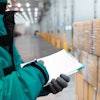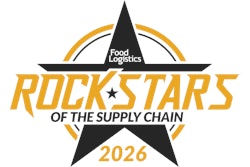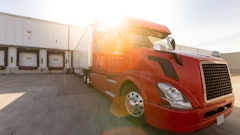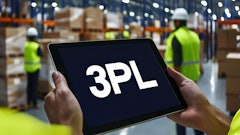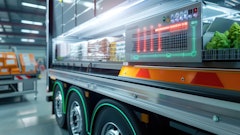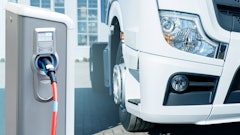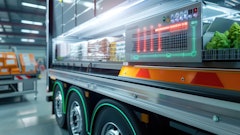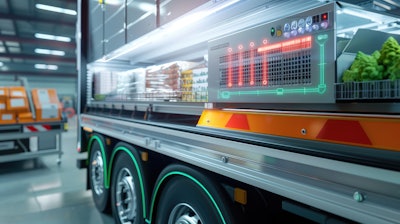
Cold storage environments are hard on workers and equipment. As demand for refrigerated and frozen goods (from vaccines to online groceries) soars, the global cold storage market is booming, rising from about $115 billion in 2021 to an estimated $428 billion by 2028. Yet up to 30–40% of the U.S. food supply is wasted due to spoilage and logistics failures. Labor shortages make staffing sub-zero warehouses especially challenging: human workers must bundle up in frigid freezers (sometimes –30°F). Under these conditions, automation is no longer optional. Warehouse managers are turning to robotics and smart technology to boost throughput, improve reliability, and maintain strict temperature control without sacrificing speed or safety.
Robotics in the cold chain
Modern robotics have been specially engineered for cold environments. Autonomous mobile robots (AMRs) and automated cranes can now operate seamlessly between frozen and chilled zones. For example, one high-tech pallet-handling system was reported to span –18°C to +5°C areas and increase storage capacity by ~70% while improving picking efficiency ~90%. These systems work 24/7 without breaks or fatigue, greatly speeding up order fulfillment. In practice, cold-storage automation often includes:
- AMRs: Wheeled robots that carry pallets or carts across the warehouse. They can navigate tight aisles and transfer loads between cold rooms and staging areas, dramatically raising throughput and reducing manual labor.
- Automated storage/retrieval systems (AS/RS): High-density rack systems with robotic shuttles or cranes. These AS/RS solutions store pallets at great heights, increasing storage density by stacking higher than human-driven forklifts allow. Tall, automated racks also mean smaller freezer openings (no large forklift needed), which cuts energy loss and cooling costs.
- Conveyors and sortation: Powered belt or roller conveyors transport packages through different temperature zones without exposure to open air. Modern conveyors are built for freezing temperatures, keeping goods moving steadily and reducing manual touches.
Behind every robot is sophisticated software: warehouse control and execution systems (WCS/WES) link the hardware to the warehouse management system (WMS). These platforms choreograph tasks, deciding which robot fetches which pallet, which lane a conveyor should route to, etc. In short, robotics automate repetitive cold storage jobs (pallet moving, high-level storage) to relieve human workers and accelerate operations.
Internet of Things (IoT) for real-time monitoring
Automation extends beyond moving boxes. IoT sensors and wireless devices give managers real-time visibility into every critical variable. Key applications include:
- Continuous temperature tracking: Networked sensors monitor temperatures, humidity, and door openings throughout the warehouse 24/7. If a freezer’s temperature starts to rise or a door is left ajar, the system instantly alerts supervisors, preventing spoilage.
- Predictive maintenance: Refrigeration units and conveyor drives can be fitted with vibration and performance sensors. IoT analytics learn normal equipment patterns and flag deviations, scheduling maintenance before a failure occurs. This avoids costly downtime and ensures each cooler runs at peak efficiency.
- Inventory visibility: Radio-frequency tags and location sensors keep tabs on every pallet or case. Warehouse staff (or the WMS) can see exactly where each product is stored and even monitor its remaining shelf life. Knowing which items are nearest expiration helps prioritize those shipments first, cutting down losses.
- Energy optimization: Smart controllers adjust HVAC and refrigeration output based on real-time data. For example, if sensors detect slightly warmer spots, the system can dial up cooling only where needed, trimming power use. In practice, IoT-based climate controls have been shown to reduce energy waste by avoiding overcooling.
By feeding this data into the WMS and analytics platforms, cold-chain operators gain a “digital twin” of the warehouse. They can spot trouble (like a power draw spike or hot spot) and respond immediately. Overall, IoT ensures conditions stay within safe bounds and provides end-to-end traceability, both essential for modern food safety compliance.
Software and systems integration
The true power of cold chain automation is realized when robotics and sensors are tightly integrated via software. A robust WMS becomes the brain of the operation. For example, incoming pallets can be automatically identified by barcode or computer vision; cameras scan each pallet’s contents and send the data to the WMS. The WMS then uses that information, along with demand forecasts and FIFO rules, to decide where to store the pallet (front vs. back of warehouse, which rack level, etc.). This automated receiving process not only saves labor but also ensures every pallet’s condition (temperature log, SKU count, sell-by-date) is recorded accurately.
On the outbound side, the WMS plans to order assembly. It tells robots and conveyors which items to pick and in what sequence, optimizing throughput. Advanced systems even calculate exactly how to stack mixed pallets (“rainbow pallets”) or how to load trucks by weight and temperature zones. Throughout, a warehouse control system (WCS) connects all software modules, ensuring that IoT sensors, vision systems, AMRs, and conveyors all work in concert. This tight integration means human managers can oversee dozens of processes from a dashboard, rather than manually choreographing each step.
Importantly, modern cold-chain systems log all activities in real time, supporting food safety rules and audits. For instance, the system can automatically compile a history of each pallet’s temperature readings and movements, showing regulators that perishable goods were kept within required ranges. In practice, end-to-end automation of data capture and decision-making delivers higher accuracy and consistency. As one operations expert notes, “less human touches means less human error,” raising inventory accuracy and meeting stringent quality standards.
Benefits: Speed, throughput and safety
Cold-storage automation delivers clear, measurable benefits:
- Higher throughput: Robots and AS/RS never tire or take breaks. They keep goods flowing around the clock. Some cold-chain deployments report roughly double the pick rates of manual warehouses and substantially higher storage throughput. Even in very cold zones, automated systems can push far more volume per hour than human-driven forklifts.
- Improved safety and quality: By minimizing human entry into freezers, automation reduces injuries and sick leave. Automated systems also enforce consistent handling. For example, goods are always stored in the correct temperature zone and with real-time temperature logs. This rigor significantly cuts food waste and contamination risks. In fact, the No. 1 benefit of cold chain automation is “improving quality and food safety,” since systems continuously monitor temperatures to ensure compliance.
- Labor efficiency: With robots handling the coldest, most repetitive tasks, fewer staff are needed in extreme environments. This addresses labor shortages and lowers turnover. Workers can be reassigned to value-added roles (maintenance, system oversight) while the machines do the heavy lifting. In effect, automation smooths out labor peaks and troughs, so staffing is more predictable.
- Enhanced visibility: Integrated WMS and IoT create a transparent warehouse. Managers see real-time inventory levels, location, and equipment health dashboards. This visibility prevents stockouts and early catches anomalies (e.g. a malfunctioning freezer). Instant data feeds also enable faster decisions. For instance, rerouting an order to another facility if a zone goes offline. Overall, real-time tracking tools have been shown to cut inventory errors and food loss substantially.
- Energy savings: Dense storage layouts and smart cooling reduce utility costs. Tall AS/RS racks minimize air volume, and only small conveyor or door openings let goods in and out, so cold air stays inside. Combined with adaptive HVAC control via IoT, many cold warehouses report lower energy bills even as throughput rises. Every degree of prevented heat leakage or wasted chill translates directly to cost savings.
Together, these technologies help cold-chain warehouses move faster, safer, and more efficiently, meeting rising food logistics demands with less waste, more accuracy, and stronger safety compliance.
As food chains become ever more demanding, automated cold warehouses will be crucial to stay ahead. Cutting-edge robotics and connectivity not only accelerate order fulfillment but also lock in the strict temperature controls needed for food safety. By embracing these technologies, supply-chain executives can achieve reliable cold-chain performance at scale, ensuring that food makes it from farm to fork quickly, safely and cost-effectively.

